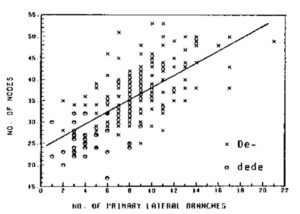Cucurbit Genetics Cooperative Report 7:3-5 (article 1) 1984
D.E. Delaney and R.L. Lower
University of Wisconsin, Madison, WI 53706
The shorter vine and concentrated fruit set of determinate pickling cucumbers are well suited to once-over mechanical harvesting (3). However, determinate and short internode dwarf types have fewer and shorter lateral branches than the normal indeterminate vine type (3,4). A wild relative of the cucumber, Cucumis sativus var. hardwickii, has both multiple lateral branching and sequential fruiting characters, and has shown potential for increasing fruit yields (1,2). The objective of this study was to examine the problem of low lateral branch number in determinate cucumbers, and determine if this situation could be improved by the incorporation of exotic hardwickii germplasm.
Four determinate cucumber lines, ‘Spacemaster’, NCSU M21, NCSU M27 and USDA 1909 (P2, P3, P4 and P5, respectively) and a Cucumis sativus var. hardwickii line, LJ 90430 (P1), were utilized in this study. The determinate parents varied in both vine length and fruit type, thus providing an opportunity to examine the effects of these characters on number of lateral branches. Four populations were generated in the fall and winter of 1982 and 1983. Each population included LJ 90430, and one of the four determinate parents, as well as the F1, F2 and backcrosses to each parent. All four populations were grown at the Hancock Experimental Station, Hancock, WI, in the summer of 1983. A split plot design with eight replications was used. Whole plots were populations and subplots were generations. Since the different generations were expected to contain different amounts of genetic variability, more plots were included of the segregating generations. Approximately 40 plants of each parent and F1, 120 plants of the backcrosses and 240 plants of the F2 were grown on 1.5 m centers.
Significant differences among generation means were observed for number of nodes and number of primary lateral branches (Table 1).
Table 1. Generation means for number of nodes, number of primary lateral branches, and ratio of nodes:laterals for two determinate C. sativus x C. sativus var. hardwickii crosses.
Generation |
No. of Nodes > mean |
No. of primary lateral branches > mean |
Ratio of nodes:laterals |
|||
|---|---|---|---|---|---|---|
Cross 1 |
||||||
| P1 (C. sativus var. hardwickii) | ||||||
| P3 (M21) | ||||||
| F1 | ||||||
| F2 | ||||||
| De_ | ||||||
| dede | ||||||
| BC11 | ||||||
| BC13 | ||||||
| De– | ||||||
| dede | ||||||
Cross 2 |
||||||
| P1 (C. sativus var. hardwickii) | ||||||
| P5 (USDA 1909) | ||||||
| F1 | ||||||
| F2 | ||||||
| De_ | ||||||
| dede | ||||||
| BC11 | ||||||
| BC15 | ||||||
| De– | ||||||
| dede | ||||||
| 1 Mean separation in columns by LSD procedure, 0.05 level. | ||||||
| 2 Range | ||||||
Data are shown for only two of the populations since trends were consistent across all populations. Among the determinate parents, ‘Spacemaster’ had the highest number of nodes, M21 was second highest, M27 had fewer nodes than M21, and 1909 had the lowest number of nodes. The same ranking was observed for number of primary lateral branches. This pattern continued for both traits in the F1, F2 and backcrosses, except for the ‘Spacemaster’ population. ‘Spacemaster’ is a slicing cucumber while the other lines are smaller fruited, Progeny from crosses between ‘Spacemaster’ and LJ 90430 had larger fruit but fewer lateral branches than the M21 population. Generally, however, determinate parents with a higher number of nodes yielded progeny with higher numbers of laterals in the F1, F2 and backcrosses. Determinate segregates in the F2 and backcrosses to the determinate parent had fewer laterals than the indeterminate segregates. The linear relationship between number of nodes and number of primary lateral branches is illustrated in Fig. 1. There were very few individuals that were classified as determinate with lateral numbers in the range of LJ 90430.
Significant differences were also observed among generations for the ratio of nodes to laterals. On the average there was a lateral for every 4 nodes on LJ 90430, while on the determinate parents and determinate segregates, there was a lateral for every 5 to 8 nodes. This indicates that determinate genotypes do not have fewer lateral branches merely because they have fewer nodes. Therefore, it should be possible to increase the number of lateral branches on determinate plant types.
Literature Cited
- Horst, E.K. and R.L. Lower. 1978. Cucumis hardwickii: a source of germplasm for the cucumber breeder. Cucurbit Genetics Coop. Rept. 1:5.
- Lower, R.L., J. Nienhuis and C.H. Miller. 1982. Gene action and heterosis for yield and vegetative characteristics in a cross between a gynoecious pickling cucumber inbred and a Cucumis sativus var. hardwickii line. J. Amer. Soc. Hort. Sci. 107:75-78.
- Prend, J. and C.A. John. 1976. Improvement of pickling cucumber with the determinate (de) gene. HortScience 11:427-428.
- Sandhu, M.S., H.C. Mohr and D.E. Knavel. 1972. Comparisons of a genetic dwarf and a normal vine cultivar of cucumber. HortScience 7:287.
